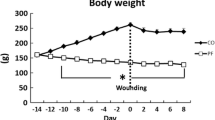Abstract
It is well known that zinc (Zn), an essential trace element, plays a role in wound healing. Although the importance of Zn supplementation in total parenteral nutrition (TPN) has been recognized, the difference in tissue Zn distribution induced by TPN and whether this difference influences local wound healing remains uncertain. Thus, we conducted a study using 30 Sprague-Dawley rats to investigate the influence of TPN-induced changes in tissue Zn distribution on wound healing at sites of intestinal anastomosis, muscle, and skin sutures. In the ordinary diet group, no significant differences were observed between subgroups with and without supplemental Zn in tissue Zn distribution or in the healing of intestinal, muscular, and cutaneous wounds. In the subgroup given a low-protein diet without supplemental Zn, a gross change in tissue Zn distribution was noted to occur with a concomitant marked decrease in Zn concentration and the tensile strength of wounded skin. These results indicate an association between wound healing and Zn concentration in the respective tissues in TPN-induced Zn deficiency with alternations in tissue Zn distribution. They also provide evidence of the local action of Zn in wound healing.
Similar content being viewed by others
References
Solomons NW (1988) Zinc and copper. In: Shils ME, Young VR (eds) Modern Nutrition in Health and Disease. Lea and Febiger, Philadelphia, pp 238–262
Pories WJ, Henzel JH, Rob CG, Strain WH (1967) Acceleration of wound healing in man with zinc sulphate given by mouth. Lancet i:121–124
Hallbook T, Lanner E (1972) Serum zinc and healing of venous leg ulcers. Lancet i:780–782
Sandstead HH, Henriksen LK, Greger JL (1982) Zinc nutriture in the elderly in relation to taste acuity, immune response, and wound healing. Am J Clin Nutr 36:1046–1059
Okada A, Takagi Y, Itakura T, Satani M, Manabe T, Iida Y, Kasahara N (1976) Skin lesions during intravenous hyperalimentation: zinc deficiency. Surgery 80:629–635
Souda S (1981) Effect of postoperative intravenous hyperalimentation on protein metabolism and wound healing. An experimental study (in Japanese with English abstract). Nippon Geka Gakkai Zasshi (J Jpn Surg Soc) 82:1492–1503
Crawford DT, Bains JW, Ketcham AS (1965) A standard model for tensiometric studies. J Surg Res 5:265–269
Adamsons RJ, Musco F, Enquist IF (1996) The chemical dimensions of a healing incision. Surg Gynecol Obstet 123:515–521
Kivirikko KI, Laitinen O, Prockop DJ (1967) Modifications of a specific assay for hydroxyproline in urine. Anal Biochem 19:249–255
Okada A, Takagi Y, Nezu R, Lee S (1990) Zinc in clinical surgery: a research review. Jpn J Surg 20:635–644
Freeman JB, Stegink LD, Meyer PD (1975) Excessive urinary zinc losses during parenteral alimentation. J Surg Res 18:463–469
Takagi Y, Okada A, Itakura T, Satani M, Manabe T, Kasahara N (1977) Zinc deficiency during intravenous hyperalimentation. A clinical analysis of eleven cases. Med J Osaka Univ 28:67–76
Takagi Y, Okada A, Itakura T, Kawashima Y (1986) Clinical studies on zinc metabolism during total parenteral nutrition as related to zinc deficiency. J Parent Ent Nutr 10:195–222
O’Dell BL (1974) Role of zinc in protein synthesis. In: Pories WJ (ed) Clinical application of zinc metabolism. Thomas, Springfield, pp 5–8
Nezu R, Takagi Y, Okada A, Inoue Y, Miyata M, Kawashima Y (1988) Effect of total parenteral nutrition on distribution of zinc in murine tissues. Trace Nutrients Res 4:115–120
Irvin TT (1978) Effects of malnutrition and hyperalimentation on wound healing. Surg Gynecol Obstet 146:33–37
Strain WH, Dutton AM, Heyer HB (1953) Experimental studies on the acceleration of burn and wound healing. University of Rechester Report, Rochester, NY, 18 pp
van Rij AM, Pories WJ (1980) Zinc in wound healing. In: Nriagu JO (ed) Zinc in the environment, part 2. Wiley, New York, pp 215–236
Prasad AS, Halsted JA, Nadimi M (1961) Syndrome of iron deficiency anemia, hepatosplenomegaly, hypogonadism, dwarfism and geophagia. Am J Med 31:532–546
Pekarek RS, Wannemacher RW, Beisei WR (1972) The effect of leukocytic endogenous mediator (LEM) on the tissue distribution of zinc and iron. Proc Soc Exp Biol Med 140:685–688
Klasing KC (1984) Effect of inflammatory agents and interleukin-1 on iron and zinc metabolism. Am J Physiol 247:R901-R904
Cui L, Takagi Y, Wasa M, Iiboshi Y, Khan J, Nezu R, Okada A (1997) Induction of nitric oxide synthase in rat intestine by interleukin-1α may explain diarrhea associated with zinc deficiency. J Nutr 127:1729–1736
Stromberg HE, Agren MS (1984) Topical zinc oxide treatment improves arterial and venous leg ulcers. Br J Dermatol 111:461–465
Savlov ED, Strain WH, Huegin F (1962) Radiozinc studies in experimental wound healing. J Surg Res 2:209–212
Author information
Authors and Affiliations
Rights and permissions
About this article
Cite this article
Nezu, R., Takagi, Y., Ito, T. et al. The importance of total parenteral nutrition-associated tissue zinc distribution in wound healing. Surg Today 29, 34–41 (1999). https://doi.org/10.1007/BF02482967
Received:
Accepted:
Issue Date:
DOI: https://doi.org/10.1007/BF02482967




